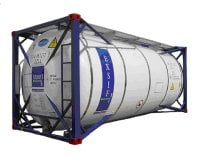20 ft. Tank Containers
20' TANK

内侧长度:
内侧宽度:
内部高度:
门的宽度:
门的高度:
能力:
轮胎重量:
最大货物重量:
6.058 m
2.438 m
2.438 m
0.000 m
0.000 m
0 m3
4190 Kgs
26290 Kgs
描述
Tank containers must be at least 80%% full, to prevent dangerous surging of the liquids in transit. On the other hand, they must not as a rule be over 95%% full, or there will not be sufficient ullage space for thermal expansion. The extent of thermal expansion may be calculated for each cargo on the basis of the following formula:
- ΔV = Va · γ · ΔT
- Ve = Va (1 γ · ΔT)
- ΔV : change in volume
- Va : volume at initial temperature a
- Ve : final volume at temperature e
- γ : coefficient of cubic (thermal) expansion
- ΔT : temperature difference in degrees kelvin
Tank containers intended for transporting foodstuffs must be labeled "Potable Liquids only".
Some hazardous materials must be transported in tank containers with no in- or outlet openings below the surface of the liquid.
Tank containers are generally designed for an operating pressure of up to 3 bar (above atmospheric). The test pressure used is 4.5 bar (above atmospheric).
If the cargo requires temperature-controlled transport, tank containers can be equipped with insulation or heating. The temperature of the cargo may be precisely controlled using temperature sensors.
根据发表在商务期刊的数据表示,DCL是目前最大的无船承运业务经营者
供私人使用
Tank containers are used for liquid cargoes, such as:
- Foodstuffs: fruit juices, spirits, sweet oils
- Chemicals: hazardous materials, such as fuels, toxic substances, corrosion protection agents


